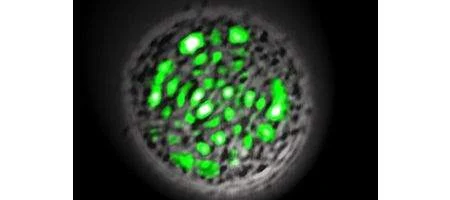Scientists, rather unbelievably, have created a functioning laser from a single living human kidney cell.

Two investigators at the Wellman Center for Photomedicine at Massachusetts General Hospital have genetically engineered the cell to express green fluorescent protein (GFP), and used it to amplify photons into nanosecond-long pulses of laser light.
“Since they were first developed some 50 years ago, lasers have used synthetic materials such as crystals, dyes and purified gases as optical gain media, within which photon pulses are amplified as they bounces back and forth between two mirrors,” says Seok Hyun Yun.
“Ours is the first report of a successful biological laser based on a single, living cell.”
The team chose GFP, originally found in a species of jellyfish, because it can be induced to emit light without any extra enzymes. They first put together a device consisting of an inch-long cylinder, with mirrors at each end, filled with a solution of GFP in water.
After confirming that the GFP solution could amplify input energy into brief pulses of laser light, they worked out how much GFP would be needed, and then developed a cell line that produced the right amount.
The laser consisted of a single GFP-expressing cell in a tiny cavity between two mirrors spaced 20 millionths of a meter apart.
And not only did it produce pulses of laser light, it also turned out that the spherical shape of the cell itself acted as a lens, refocusing the light and generating the laser effect at lower energy levels than the solution-based device had required.
The cells used survived the process and carried on to produce hundreds of laser pulses.
“While the individual laser pulses last for only a few nanoseconds, they are bright enough to be readily detected and appear to carry very useful information that may give us new ways to analyze the properties of large numbers of cells almost instantaneously,” says Yun.
“And the ability to generate laser light from a biocompatible source placed inside a patient could be useful for photodynamic therapies, in which drugs are activated by the application of light, or novel forms of imaging.”
The investigators say they hope the technique could help optical communications and computing to merge with biotechnology. Their next step will be to implant a structure equivalent to the mirrored chamber actually inside a cell.






